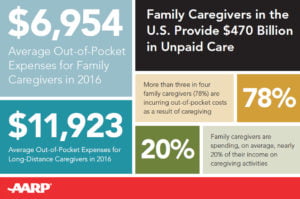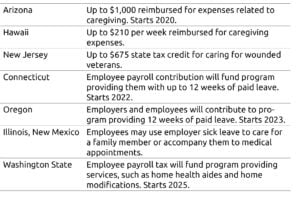
States Give Financial Help to Caregivers
On Jan. 1, Arizona residents caring for elderly or disabled family members became eligible for up to a $1,000 reimbursement from the state for expenses incurred in their caregiving responsibilities.
This is a trial program and the legislature allocated very little money – $1 million over two years – in a state with an estimated 800,000 residents caring for a disabled adult over 18.
But it’s a start.
Caregivers “aren’t asking for everything. They’re asking for a little bit to make their lives better,” said Elaine Ryan, vice president of government affairs for AARP, which has been on the forefront of advocating for such policies at the state level. “That’s the least we can do.”
Arizona’s program would defray a portion of caregivers’ spending. For older family members, this would cover technologies to aid older family members, such as hearing aids or computer programs, or shower grab bars and wheelchair ramps.

Like Arizona, state governments around the country, as laboratories for policy experimentation, have passed a hodgepodge of programs to support caregivers. Other bills approved in recent years range from New Jersey’s tax credit for military families caring for wounded veterans to Oregon’s paid family leave program for workers taking care of aging spouses, parents and grandparents.
The programs are a tacit acknowledgment of the enormous financial strain caregivers face – a strain that is only expected to grow and, increasingly, to affect Millennials as their baby boomer parents age.
However, it’s not easy to pass bills that require states to approve financial assistance or tax credits, because the work done quietly by family caregivers is often invisible and under-appreciated by the general public and federal and state legislators.
Alex Juarez, spokesman for AARP Arizona, said it took three tries over three years to get the reimbursement bill passed, which required raising awareness among lawmakers who’ve never been caregivers themselves. “We had to build quite a bit of awareness and [do] bipartisan work on both sides of the aisle,” he said.
Juarez said that the assistance will be especially important to low-income people.
 Indeed, caregiving expenses can be substantial. The average caregiver spends nearly $7,000 per year for everything from medical supplies and prescriptions to transporting elderly people, according to an AARP survey. These costs increase to nearly $12,000 when the caregiver must travel to assist family members in distant locations.
Indeed, caregiving expenses can be substantial. The average caregiver spends nearly $7,000 per year for everything from medical supplies and prescriptions to transporting elderly people, according to an AARP survey. These costs increase to nearly $12,000 when the caregiver must travel to assist family members in distant locations.
In addition to money concerns, the six out of 10 caregivers who simultaneously juggle a full- or part-time job must deal with disruptions to their work. Some state programs are targeted to them. For example, new laws in Iowa, North Dakota, and Tennessee require hospitals to provide adequate notice before discharging a family member from the hospital, AARP’s Ryan said.
Even simple measures like these “can go a long way to [helping caregivers] support loved ones,” she said.
Squared Away writer Kim Blanton invites you to follow us on Twitter @SquaredAwayBC. To stay current on our blog, please join our free email list. You’ll receive just one email each week – with links to the two new posts for that week – when you sign up here. This blog is supported by the Center for Retirement Research at Boston College.
Comments are closed.







This is a critically-important issue. As we age as a society, and as multi-generational households fade into the June Cleaver era, who will take care of the frail elderly? Home health aides are woefully underpaid, and are largely the immigrant groups that Trump administration is trying to keep out. We must put more resources into social supports (and less into over-priced traditional medical care).
What is the procedure to file for this in Arizona?
The program is administered by Arizona Department of Economic Security. For more details please visit https://des.az.gov/services/older-adults/family-caregiver-support
or call the Caregiver Resource Line, 888-737-7494.